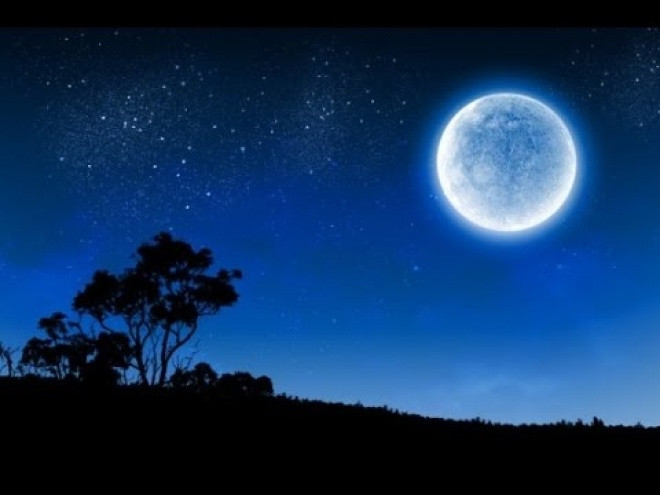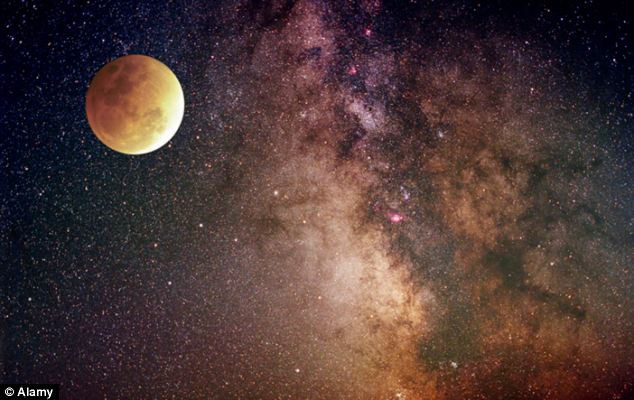Blue moon and Mars together illuminate tomorrow night sky
On May 21-22, astronomers all over the world not only have the opportunity to follow the rare blue full moon but also can observe Mars in the closest position to the Earth.
According to Futurism, the Moon is like blue in the middle of the night sky. This is a very rare phenomenon, because dust particles in the atmosphere disperse light, causing the Moon to be blue when viewed from the ground.

Blue moon is a rare astronomical phenomenon.(Photo: Earthsky).
Earthsky.org offers two definitions of blue moon. According to the traditional concept, from the blue moon used to indicate the third full moon in a season there are 4 times the full moon. The season here is the time between the lice day (winter solstice or winter solstice) and the feces (spring or fall). Usually, there are only three full moons each season. Therefore, the full moon event takes place 4 times in an extremely rare and unprecedented season since August 2013.
Another definition of blue moon is the second full moon in the same calendar month. Astronomers calculated 235 times of the full moon in 19 calendar years, corresponding to 228 months. Thus, 7 in 19 years will have 2 full moons in the same month and 4 times of the full moon in a season.

Mars will be closest to Earth within a decade.(Photo: Alamy).
At the same time as the blue moon, Mars will lie in line with the Sun on May 22 , when Earth passes between Mars and the Sun this week. This event occurs every 2 years and 50 days. The brightness of Mars in the sky depends on the position of this planet and the Earth in orbit around the Sun. This year, Mars will be in the closest position to Earth within a decade, giving astronomers the opportunity to observe most clearly.
- Impressive points about Blue Moon
- Interesting things few people know about the Moon
- Enjoy the beautiful fantasy 'blue moon' on the night of the Full Moon in July
- Tomorrow, there will be the moon
- See the second blue moon in 2018
- Photos: Super blood moon and blue moon all over the world
- Mars, Moon and Venus are lined up in the English sky
- How to see the blue moon, the blood moon online tonight 31/1/2018
- Later this month there will be a 'blue moon'
- Russia will launch ships to collect specimens from the moon Mars
- Decode the phenomenon of the moon
- Moon rainbow and aurora together appear in Sweden
 Van Allen's belt and evidence that the Apollo 11 mission to the Moon was myth
Van Allen's belt and evidence that the Apollo 11 mission to the Moon was myth The levels of civilization in the universe (Kardashev scale)
The levels of civilization in the universe (Kardashev scale) Today Mars, the sun and the Earth are aligned
Today Mars, the sun and the Earth are aligned The Amazon owner announced a secret plan to build a space base for thousands of people
The Amazon owner announced a secret plan to build a space base for thousands of people This Abundant Mineral on the Moon Could Power Humanity for Thousands of Years
This Abundant Mineral on the Moon Could Power Humanity for Thousands of Years  The Strange Disease That Affects Everyone Who Has Ever Set Foot on the Moon
The Strange Disease That Affects Everyone Who Has Ever Set Foot on the Moon  What would a day on the Moon be like for astronauts?
What would a day on the Moon be like for astronauts?  First photo of Mars' strangely shaped moon
First photo of Mars' strangely shaped moon  The biggest supermoon of the year is about to light up the world's skies
The biggest supermoon of the year is about to light up the world's skies  New research shows that Earth has a new 'Moon'
New research shows that Earth has a new 'Moon' 